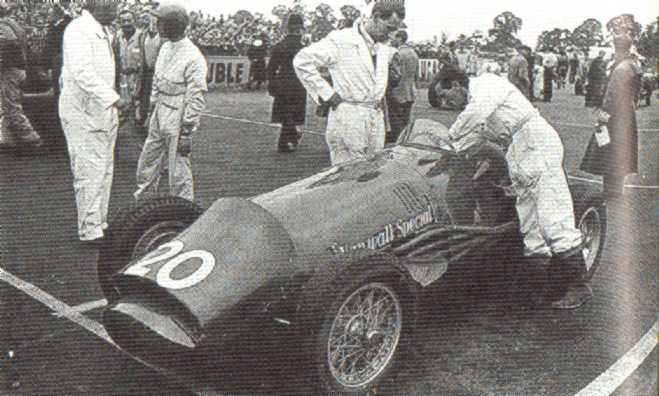The Vanwall Grand Prix engines
Part 2: The 2.3-litre interim F1 engine
Author
- Ron Rex
Date
- January 8, 2020
Related articles
- The Vanwall Grand Prix engines, by Ron Rex
- Introduction
- Part 1: The 2-litre F2 engine
- Part 3: Technical anomalies
- Part 4: The 2.5-litre F1 engine
- Part 5: The 'AvGas' 2.5-litre F1 engine
- Part 6: The 2.6-litre Intercontinental Formula engine
- Part 7: Finality and overview
- Part 8: Specifications and other facts
- Vanwall - The Green Comet: the brief history of the Vanwall, by Don Capps
- Vanwall - Vanwall's inconspicuous entry to the GP world, by Felix Muelas/Don Capps
Who?Peter Collins What?Vanwall Special Where?Silverstone When?7th RAC British GP (July 17, 1954) |
 |
Why?
Pending completion of the 2.5-litre engine which involved a considerable re-design of components, a second engine was built based on the same components as the 2-litre one but with the bore increased to 91mm (while retaining the original stroke of 86mm) to give a larger swept volume of 2,236cc (VP referred to it as 2.3 litres).
Detailed changes
This was the largest bore that could be accommodated in the B40-based Vanwall crankcase without increasing the cylinder centre spacing. The B40 had a cylinder centre spacing of 105.4mm (4.15”) so the 91mm bore was a very tight fit, reducing the space available between cylinders for the seating of the top flange of the cylinder barrels onto the cylinder head by 5.07mm.
This interim 2.3-litre engine was essentially the same as the first 2-litre one, retaining its features, but because of the enlarged bore changes were required to the crankcase, cylinder barrels, pistons and the cylinder head.
This would have required:
- The crankcase cylinder barrel openings to be enlarged
- New 91mm bore barrels and 91mm diameter pistons to be produced
- The cylinder head spigot recesses and flange seatings for the cylinder barrels increased in diameter by 5.07mm to accommodate the larger bore barrels.
Otherwise, the engine was the same and retained the 4 main bearing crankshaft, the four Amal carburettors and the valve sizes of the first 2-litre engine.
There was one significant difference though: the double-bodied B.T.H. magneto was finally available and was fitted in place of the previously used Scintilla magnetos. It was mounted longitudinally on the front of the secondary gear case, driven directly by the same take-off shaft as used to drive the Scintillas. The secondary gear case was modified and extended up above the magneto with a blanked-off portion, possibly for mounting the proposed fuel injection pump.
2.2 Race Performance and Development 2.3 Litre 1954
No power output has been publically disclosed for this engine, but based on the output of the 2-litre engine it probably developed 240-250bhp .
This interim 2.3-litre engine was completed in July 1954 and installed in the Vanwall Special and the next appearance of the car was in the British GP at Silverstone on 17 July, driven by Peter Collins. Collins qualified it on the third row of the grid and it ran well in the race amongst the 2.5-litre cars until a cylinder head joint leaked, forcing its retirement.
For this race an aluminium air duct was fitted over the double layers of Clayton-Still gilled tube water radiators and it was reported that Amal float chambers were used. Presumably experiments were still ongoing in this regard.
The engine failure caused much worry and Wills, the manufacturer of the pressure rings that sealed the joint between head and cylinders, thought that the head might be moving about on the rings and suggested a thinner type which they set about manufacturing. The cylinder head's low beam strength may not have helped.
Meanwhile, the 2.5-litre engine had been completed and an entry was made for the Italian GP in September, but while it was running on the test bed in preparation for the race it broke a valve which caused considerable damage that could not be repaired in time, so the 2.3-litre engine was substituted instead.
Anticipating the high speeds and high ambient temperatures at Monza, changes were made to the engine cooling system. The ducted tube radiators were replaced by a conventional one, using a standard Morris Oxford matrix for the core as it met design requirements . The nose now had a normal open air inlet but the oil/water heat exchanger was still retained. The radiator was modified to allow insertion of the portable electric starter through it.
Collins drove the car again; there were carburation problems in practice, but in the race it was reported as sounding smooth and crisp and was able to run with a lot of the 2.5-litre opposition until a broken pipe to the oil pressure gauge caused a pit stop for repairs, but the car ran on to finish seventh.
The new cooling system proved very effective. Engine inlet water temperature was held at 65.6° C throughout the race, while the outlet water temperature did not rise above 85° C. The new cooling system held a total of 13.6 litres (3 gallons) of water while the water pump circulated it at a rate of 189.4 litres (41.7 gallons) per minute at an engine speed of 6,000rpm.
This was the last use of the 2.3-litre engine, as in future the 2.5 litre was available.
